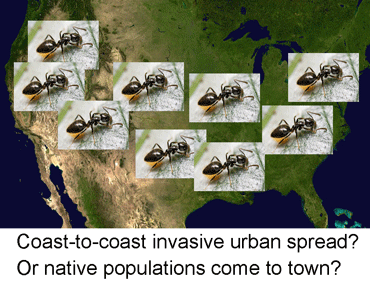 DNA helps answer the origin of infectious diseases: are cases sporadic events or part of larger epidemic, such as the recent Salmonella Montevideo outbreak involving at least 245 persons in 44 states, traced to a single importer of crushed red pepper used in salami manufacturing. In a similar way, DNA helps answer the origin of apparently widespread species–are they part of single outbreak so to speak, or are they multiple independent populations or species. (This suggests useful connections between phylogeography, the genetic study of populations, and molecular epidemiology of disease.) As with pathogen diagnostics, a minimalist DNA testing approach will help make feasible analyzing large numbers of specimens.
DNA helps answer the origin of infectious diseases: are cases sporadic events or part of larger epidemic, such as the recent Salmonella Montevideo outbreak involving at least 245 persons in 44 states, traced to a single importer of crushed red pepper used in salami manufacturing. In a similar way, DNA helps answer the origin of apparently widespread species–are they part of single outbreak so to speak, or are they multiple independent populations or species. (This suggests useful connections between phylogeography, the genetic study of populations, and molecular epidemiology of disease.) As with pathogen diagnostics, a minimalist DNA testing approach will help make feasible analyzing large numbers of specimens.
In February 2010 PLoS ONE, six researchers from University of North Carolina report on Odorous house ant Tapinoma sessile (smells like rotten coconuts when crushed), collected from 47 urban and rural localities across the US. According to the authors, T. sessile is the most common and widely distributed ant in North America, found “from the West coast to the East coast and the deserts nearly all the way to the tundra.” The structure of the 18 colonies examined in detail ranged from a monogynous (single queen) colony in an acorn with 50 workers, to a polygynous colony with 2 queens and 250 workers, to a large, dispersed colony of “several million workers and thousands of queens in and around several buildings on a college campus.” For DNA analysis, 68 individual were analyzed (1 from each of the 18 colonies, plus 23 collections in natural environments made by entomologists, 26 collections in urban environments mostly provided by pest control professionals, and 1 T. erraticum specimen). Menke and colleagues found 4 distinct genetic groups, corresponding to geographic areas, with 7.5 – 10% COI sequence differences among groups, and relatively small (0.2 – 2.3%) differences within groups, a pattern that “may represent multiple species.” Counter to initial expectations, urban ants were genetically similar or identical to non-urban ants within each region, and colony structure was not associated with urban vs natural environment, namely monogynous and polygynous colonies were found in both environments.
I conclude there is much we don’t know about the commonest, most everyday species, and that DNA barcodes are just the right size for many of the relevant scientific and practical questions. In closing, for a view of complexity of ant life, please see E.O. Wilson’s wonderful short story “Trailhead”, in March 6, 2010, New Yorker, an excerpt from his upcoming book Anthill.